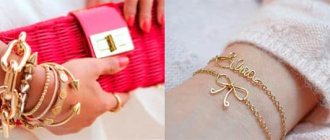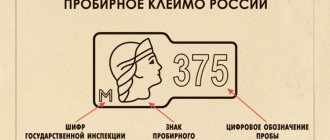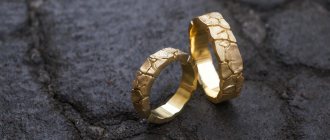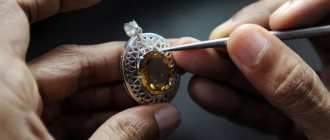The list of the most expensive metals on the planet is unusually short. And gold is rightfully included in it. Rare, beautiful, practically eternal - although why “practically”? – gold has passed all stages of selection and not only adorns the list of precious metals, but is also a permanent favorite of the people.
Especially regarding the issue of wedding rings. They say about gold: “An eternal metal – for eternal relationships.” Isn't this a hint to future newlyweds which metal to turn to when choosing the most important jewelry?
Gold is very soft. It melts at a temperature of only 1063.4° C. It is practically plasticine. Just imagine, just 28.3 grams (1 ounce) is enough to produce a wire five kilometers long or the thinnest blanket with an area of 9.3 square kilometers!
It is logical that it is not used in its pure form for the production of jewelry - this would be completely impractical. Therefore, pure gold is mixed with other metals - for strength, among other things, but also to improve casting properties and give different shades. Impurities of metals involved in the alloy are called alloys. So, depending on the amount of ligature, the gold alloy can acquire the familiar shades of yellow, red or white.
Carats and fineness
The purity of gold is measured in karats and fineness. 1 carat is equal to 1/24 of the alloy weight. For example, 24 karat gold (24K) is pure gold without any impurities. And 18-karat gold (18K) means the alloy contains 18 parts gold and 6 parts impurities.
In Russia, the metric system is adopted: the purity of gold is measured by its fineness. The fineness ranges from 0 to 1000 and shows the gold content in parts per thousand. Gold of 999.96 purity is considered “virtually pure”; this is the value indicated on the bars. The most popular hallmarks of gold products: 585, 750 and 958. “Translation” from karat language to hallmark language below:
23 K = 958 hallmark (share of pure gold 98.5%) 18 K = 750 hallmark (share of pure gold 75%) 14 K = 585 hallmark (share of pure gold 58.5%) 12 K = 500 hallmark (share of pure gold 50 %) 9 K = 375 standard (pure gold content 37.5%).
Pure gold is always yellow, but the color of the alloy can change depending on the amount of impurity. Typically, jewelry gold contains copper, zinc, silver and nickel.
Gold jewelry comes in a variety of colors, and popular shades may vary from country to country. For example, in jewelry stores in Europe, America or Eastern countries it is easier to buy a wedding ring made of yellow gold, due to its greater popularity. In our country, this metal is still a rarity, and not every store will offer jewelry made from it. However, there have always been connoisseurs of yellow gold among our compatriots; people prefer this color as the closest to natural. Plus they like the rich sunny shade.
Marking systems
All alloys that are used to make jewelry and other decorations contain a certain amount of yellow metal. So that the buyer has an idea of how much gold there actually is in the product, a system of special signs and designations has been developed . There are 4 known systems in total:
- carat;
- metric;
- spool;
- lot.
The last two have not been used for a long time; they are a thing of the past. The spool test was based on the value of the Russian pound, which was 96 spools. It was widespread until 1927, after which a transition was made to another system - the metric one. Lot designations were used mainly in Germany, but this country began to use metric samples even earlier.
The USA, Canada and most other Western countries prefer the karate system. According to accepted standards, a 24-carat precious metal is considered pure and without impurities. The remaining alloys, which are supplemented with other metals, are marked respectively at 9, 10, 14, 18 carats. For example, an 18-karat gold piece is made from 18 parts of the base yellow metal and 6 other components included in the alloy.
What affects practicality
Precious metals are soft, and to regulate this quality, base metals are added to the alloy. And the more other metals in the composition (the lower the sample), the more practical it is considered. You should not think that such products are not susceptible to scratches - scratches during wear are inevitable in any case, but they are less deep, and some can be removed with a simple polishing cloth. Nevertheless, high-grade products are very popular - because even if their surface is damaged during wear, it can be easily restored in a jewelry workshop.
So what is gold purity?
Sample (Probe German; Probo Lat. - I evaluate, test) - a unit of measurement, the percentage of precious metals: gold, silver, platinum, etc. The sample is indicated in a digital designation to understand the real amount of precious metal in jewelry, a precious coin or bar, where it is placed in the form of a hallmark and is strictly controlled by law.
There are four types of sample calculation systems: metric, spool, carat and lot. The most popular are the metric and carat systems.
Which rings to choose?
A little trick - if you want your engagement ring to require minimal maintenance, choose textured options. Patterned jewelry also wears out, but due to the texture it is not noticeable. A good example: Ring Studio wedding rings in the shape of twigs, dragons, checks, or any other piece with a rough texture.
If this design is not close to you, look at the fingers of foreign movie heroes. An attentive viewer will notice the characters’ preferences: round paired rings with a comfortable fit, “washers,” jewelry with a diamond path.
Similar gold rings can also be seen in the Ring Studio showcases in Moscow and St. Petersburg. But you don’t have to come, photos of all models are posted on the website, so it’s easy to order them online.
Types and forms of brands
Precious jewelry is marked not only with gold hallmark numbers. All products must be branded. The applied mark may have a different shape, depending on the country of origin and the designation system adopted there. In Russia, two types of printing are most often found:
- image of a female profile facing the right side;
- a hammer and sickle located on a five-pointed star.
Regardless of the shape and type, the mark must contain mandatory information: the code of the service that applied the seal, the marking of the content of precious metal in the alloy used and the symbol of the assay service’s identification. The cost of products is directly proportional to the percentage of precious metal.
It is almost impossible for a simple buyer who has no experience working with jewelry to determine the authenticity of the applied mark. Often very good and high-quality fakes with 585 or even 750 purity are passed off as real gold. In fact, scammers have learned to illegally apply samples and deceive consumers. To check whether the value of the mark corresponds to the true content of the precious metal, a visual inspection with magnifying devices and additional testing procedures will be required.
The surface of the gold object is first cleaned, then passed over the surface of a special stone. There should be gold stripes left on it, onto which you need to apply reagents. If the sample is high, then the remaining strokes will not disappear and will not even change color. If the strips have completely dissolved, it means that the product is of low quality or does not contain yellow metal at all. At home, it is extremely difficult to determine the quality of products , and it is not even always clear whether it is gold or silver. The 325th standard is the lowest that is allowed in jewelry production; it may outwardly look like a gold-plated silver product.
325 gold items are in demand and highly valued in England and some other countries. In Russia, this metal is considered low-grade. Separately, we can highlight jewelry with the designation 588. They are made of a high-quality alloy, including 11 parts of yellow metal and 1 part of elite platinum. The cost of such goods is much higher. Elite items also include items marked 983; their price can be extremely high due to the use of noble red gold.
Where can you buy or sell
Products made of 585 or 750 carat white gold are offered by jewelry houses, small shops and websites:
- jewelry, especially with stones, looks respectable;
- The fashion trend is to decorate yourself with gold of different colors.
Although self-respecting stores practice buying items back, it is difficult to sell even 750-karat jewelry for an adequate price. Pawn shops only take into account the weight (scrap), often without the work of a jeweler, the artistic value and carat of the stone. It is more common to buy traditional red or yellow gold “from hand”; They look askance at white.
You can try placing an offer at an auction (both in real life and online) or look for a client on specialized sites.
My advice: keep all tags and certificates for the product - having documents will speed up the sale.
White gold price per 1 gram
The price of white gold per 1 g depends on:
- From the sample. So, in a 2 g product, gold of 750 purity is 1.57 g, and gold of 585 purity is 1.176 g. With external similarity and the same weight, the former will cost more.
- Because of the “nobility”, platinum (palladium) additions raise the price.
- From gold exchange rate quotes.
This is the lower bar (for buying). Further, the price of the product includes work, production costs, sales margin, advertising, brand... Therefore, by the way, jewelry is not suitable for investment - there are too many unnecessary components in the price.
I looked at the sites of purchases and pawnshops - they don’t highlight white gold as a separate line, they give a general table. Which, in general, is logical - no matter what the additives are, the percentage of solar metal is the same.
| Try | Price, rub./g |
| 585 | 1770–1775 |
| 750 | 1950–2050 |
How do you get it?
For a person far from alloy technology, jewelry making seems simple. I threw pieces of metal into the crucible according to the proportions, put them on the burner, mixed them and cast the decoration. Unfortunately, metals are characterized by different melting temperatures: gold is already gurgling with might and main, but copper continues to float in pieces.
The production of noble white gold is possible at a temperature of about 1000 °C, base gold - 600...700 °C (annealing). Additionally, reagents are used (for example, boric acid), so the presence of other impurities is specified in the recipe. After annealing, the alloy is cooled slowly to prevent cracking.
This is how two alloys with different physical properties are obtained:
- Plastically deformable (based on Au, Ag, Pd). It is used for the manufacture of blanks by sheet stamping or manual processing.
- Casting alloy (Au, Cu, Ni, Zn). Used for precision casting workpieces.
The history of the appearance of white jewelry alloy
Products made from white gold were delayed for a decade. They appeared in the collections of jewelry houses after the end of the First World War.
First, craftsmen began to actively use platinum: at the beginning of the 20th century. The “garland style” came into fashion (founder Louis Cartier). Silver is a soft metal. To make the product stronger, it was necessary to duplicate the frame with gold. The jewelry turned out to be massive and uncomfortable to wear.
In 1910, Diaghilev's Russian Ballet performed in Paris. “Scheherazade”, with its luxurious decorations and rich multi-colored robes, made such a strong impression on the public that oriental motifs, Turkish trousers and colorful robes came into fashion.
Jewelers begin to conduct “chromatic experiments,” but the war cancels out all plans. Platinum disappears from the market (used in the military industry), and England imposes an official ban on trade in this metal.
After the war, fashion changes: the geometric linear design of gold jewelry requires a modern color scheme. Then brooches, bracelets, clips, and “collars” appear en masse. At the peak of popularity, women's wristwatches in white gold cases (it would enjoy similar success in the 1990s).
Where is white gold used?
Any colored gold is intended for mass-produced jewelry. Made from white:
- jewelry with stones;
- “mix” in combination with individual gold elements of a different color;
- cigarette cases, medals, watch cases.
Tips for care, cleaning and storage
I have written a short reminder on caring for white gold jewelry - use it.
- Every thing has its place! Jewelry is not stored in bulk; it is carefully laid out in compartments so as not to damage the stones or scratch the surface.
- Precious metal is covered with craters under the influence of acids or hot alkali. Therefore, wash the jewelry with soapy water without aggressive chemicals. Rinse with warm water and polish with a flannel.
- It is acceptable to use dry tooth powder or gruel with water for cleaning.
How to distinguish a fake from the original
The buyer does not carry reagents in his purse to the store. To distinguish a fake from an original, you should carefully examine the product.
The jewelry is marked:
- The types of stamps for each metal are different. Any product made of white gold in the Russian Federation must have the following mark:
- shaped like a spatula;
- a clear drawing of a girl in a kokoshnik;
- sample number 750 and 585;
- the letter in front of the picture is the code of the State Inspectorate of Assay Supervision.
- To the left or above the sample there must be a nameplate (numbers and letters of the name of the manufacturer, year of manufacture of the jewelry). The manufacturer's mark is approved and published by the Ministry of Finance of the Russian Federation.
A product purchased abroad may bear a “general mark” (by the way, it is placed at the request of the client). The “scales” pattern is used, mainly on watches. White gold products with such a hallmark are original, since the “common hallmark” was adopted in the EEC at the Vienna Convention to facilitate trade in jewelry.
There may be a print with the image of the rising sun and the sample number. Products with it are also original, and the drawing belongs to the international association Emagold (120 countries).
In order not to be deceived, especially for tourists, I recommend that you check the official state stamp before the trip (for example, an eagle in France).
How to distinguish white gold from silver and platinum
In addition to different markings (stamp), all of the listed products differ in color. White gold of any standard has a yellowish color. Silver is characterized by its silvery-white color, while platinum is naturally pure white (“steel-like”) in color.
Tips for choosing white gold jewelry
My jeweler friend recommends:
- choose 750th sample - it is stronger than 585th;
- look for nickel-free ligature (require a certificate for the product, not a tag);
- check for the presence of a mark.
Decorations in the following styles remain popular:
- minimalism;
- naturalism (flowers and leaves) with oriental ornaments;
- mix (several shades of gold at once).
The main thing is that you should like the jewelry to the point of butterflies in your stomach - girls understand what I mean.
By the way, it is not recommended for children, teenagers and people with unstable mental health. Precious metal spoils character and gives an illusory reason to look down on people.










